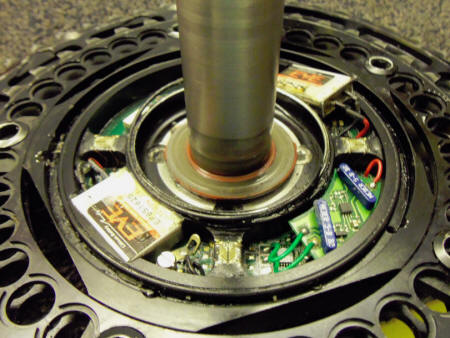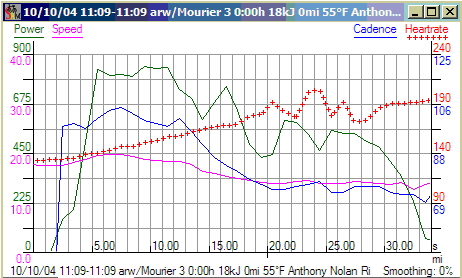FAQ ~ Power Meter v Turbo

sprinter power meter face off ~ me and Mario giving it large
Is there a significant difference between the power readings on a turbo
and those of a power meter?
Malcolm Skelly ~ Jersey

the inner workings of a wireless SRM power meter
it's the little "gold squares" on the cross bars measure the "power"
it's the little blue boxes that switch it on and count the cadence
All power is equal, but some power is more equal than others.
A watt, is a watt. It's a scientific measurement and has clearly defined parameters. But what you see reflected on your viewing screen of choice, being reported by your measuring device of choice, is not always the same. But that's not always a bad thing.
Measurement v Calculation
First the differences; a power meter measures power, a turbo (generally) calculates
power. A small but subtle difference.
A turbo applies a known resistance to the spinning rear wheel and measures your efforts to overcome it.
If it knows the applied load (torque), and can measure the pedal cadence, it can calculate the power (torque x rpm) used to overcome that load. It then, at some pre-calculated point, presents this to you on a screen.
 Some
turbos are capable of calculating cadence by measuring the speed of
the roller (and the known tyre circumference), and comparing that with the load applied, to reverse
engineer a "rough but close enough" gear ratio.
Some
turbos are capable of calculating cadence by measuring the speed of
the roller (and the known tyre circumference), and comparing that with the load applied, to reverse
engineer a "rough but close enough" gear ratio.
It can then make an educated guess to the pedal cadence as "x revs, in y gear, gives z speed". Genius!
A power meter, through the gold strain gauges above, measures the torque (twisting force) applied to the crank (or wheel in the case of a Power Tap) and multiplies that by the speed the device is moving, to present a power output on your screen.
 Display
Attributes
Display
Attributes
Now we come to the screen itself! What's presented on the screen
is determined by your power unit and the screen set up.
An SRM can measure in half-second intervals, so it's "very jumpy" (stochastic is the technical term), but we'll save that for another day.
Quarqs and a few others measure in "one second" intervals. So every second, it updates the display.
Others measure in "buckets". When the bucket is full it sends the data it has to the display. Depending on circumstances, this can be slightly less, or slightly more, than a second per transmit.
These are very subtle differences, and normally you would never notice. But when you have multiple units on a bike (for testing obviously!), or do deep analysis and track heart rate, you really see the difference.
Turbos can be anywhere from one to five second data capture. So what you will see on the screen is what happened averaged over five seconds; not what's happening during the current two pedal revs.
Does It Matter
 As you can see, lots of variables, variations and vagaries.
But it doesn't really matter!
As you can see, lots of variables, variations and vagaries.
But it doesn't really matter!
As long as what you have is consistent, and relevant to you then all is good.
It may cause a slight issue if you use one system for the turbo and one for the road, but you just need to factor in the differences.
This can be easily undertaken with a power meter mounted on a turbo and the power curves matched over a steadily increasing wattage range. **
And as with all our sessions, it doesn't matter what the number is. The numbers are used to record your sessions, not drive them.
If you have to do five, six minute intervals, your objective is to "just" get to the end of the last one.
We use the Goldilocks principle; if you can't you've gone too hard. If you can easily, you've not gone hard enough. If you've just managed to hang on, then you've done the best you can.
There is no point in chasing numbers you can't hit. All you can do is all you can do. Don't be a slave to the machine.
The numbers between your turbo and power meter could be ten, twenty, thirty watts out, depending on a host of variables. Obviously a calibration would help, but the big thing is consistency. You have to be sure that the number you are seeing is consistent rather than scientifically accurate to two decimal points.
A 10% improvement is a 10% improvement, no matter what system you are using. But make sure you always measure like for like.
one of my very first power files from 2004!
And finally, remember this. A power number is as good as useless unless you can put it in to context. Power numbers are nice, but power to weight numbers are what's important.
Watts per kilo are where the good coaches work. Pay as much attention to your weight as you do your power output.
Here's a bit more on turbos...

** When I say "easily undertaken" I did this with flamme rouge Road Captain Jason Stratford (right). He got the easy bit, offering encouragement with a laptop, clipboard and his polynomial equations; I did the pedalling. It wasn't pretty!
And here's what Mario thought when we showed him the photo...










